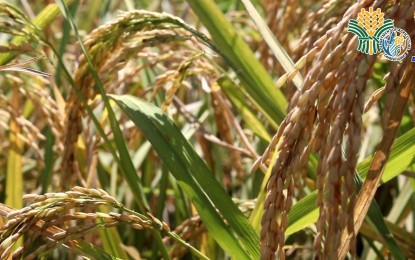
INCREASED HARVEST. Rice farmers in Nueva Ecija have reported higher palay yields this wet season. Fernando Salvador, chairman of the Binabuyan Farmers Association in Barangay Pinili, San Jose City, Nueva Ecija, said on Thursday (Oct. 19, 2023) that the Department of Agriculture’s effective interventions have boosted their production from 60 to 70 cavans per hectare to 100 to 120 cavans per hectare. (Photo courtesy of DA Region 3)
CITY OF SAN FERNANDO, Pampanga – Rice farmers in Nueva Ecija attained higher palay harvests this wet season which can mainly be attributed to the government’s various agricultural interventions.
Fernando Salvador, chairman of the Binabuyan Farmers Association in Barangay Pinili, San Jose City, Nueva Ecija, said on Thursday that the Department of Agriculture’s (DA) support to the rice farmers has played a significant role in boosting their income.
He said the inbred certified seeds from the Rice Competitiveness Enhancement Fund (RCEF) – Seed Program, as well as new farming techniques and practices they learned and adopted, doubled his yields.
“Ngayong rainy season inbred po ang tinanim ko at naabot po namin ang mas mataas na ani at dahil sa mga ginagawa naming pag-aalaga sa aming mga palay ay talaga namang umabot ng higit sa isang daan kaban ang aming ani (This rainy season, I planted inbred seeds and we attained higher yields and because of the ways we are taking care of our palay, our harvest reached more than a hundred cavans),” Salvador said in video interview of DA-3 (Central Luzon).
In the past years, Salvador said their palay yields normally averaged only 60 to 70 cavans per hectare but now, this has gone up to 100 to 120 cavans per hectare.
He added the suitable rice seed varieties being recommended by the DA-Philippine Rice Research Institute helped boost their production.
Salvador said he plants NSIC RC 402 during the rainy season and hybrid rice during the dry season.
His fellow farmers in their community also attained similar success in yields through the adoption of the new agricultural practices.
“Dati sabi nila magsasaka lang kami ng dayami pero ngayon, kami ay magsasaka na umuunlad. Ako bilang magsasaka umangat po ako, tumaas po ang lebel naming mga magsasaka sa ngayon (They used to say we were just straw farmers but now, we are farmers that are thriving. Our level as farmers increased),” he said.
Salvador thanked President Ferdinand R. Marcos Jr. for leading the DA.
“Nararamdaman po namin ang pagsusumikap ni President Marcos upang tulungan pa kaming mga magsasaka. Kung tutuusin, sobrang malaking tulong ang mga proyektong kaniyang isinusulong, sana po ay hindi siya magsawang gumabay at bigyang halaga kaming mga nasa pagsasaka (We feel the efforts of President Marcos to help us. After all, the projects he is promoting are very helpful, I hope he will not get tired to guide and value us who till the lands)," he said.
Based on the data from DA Regional Field Office 3 - Rice Banner Program, the total area planted with palay in Central Luzon covers 457,782.61 hectares this wet season.
Regional Rice Program focal person Lowell Rebillaco said that as of Oct. 6, a total of 71,568.06 hectares planted with palay have been already harvested. (PNA)
